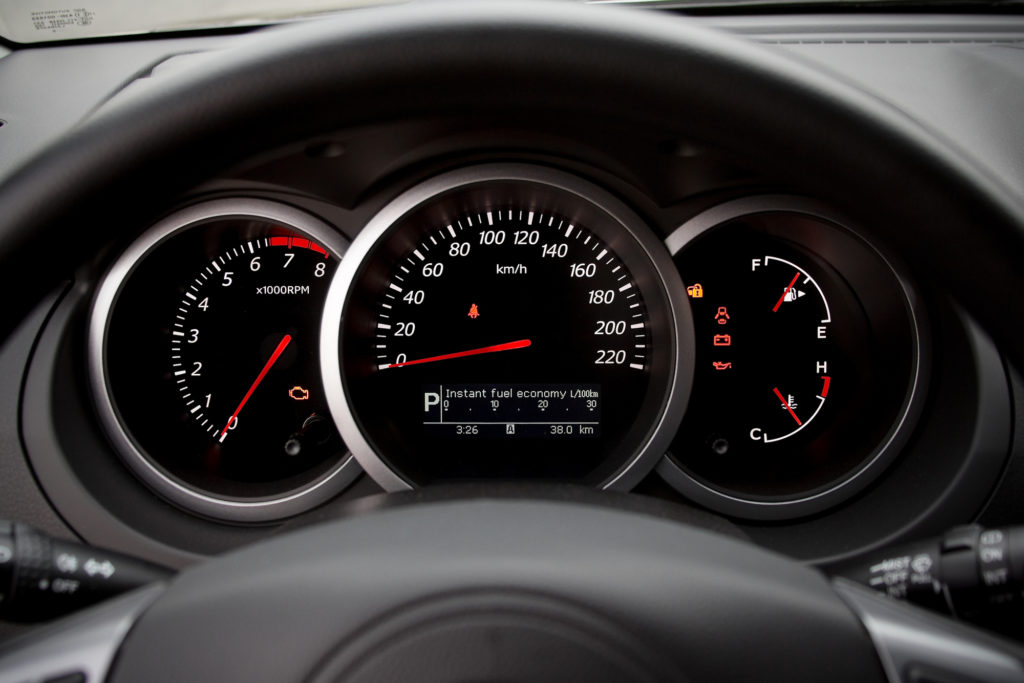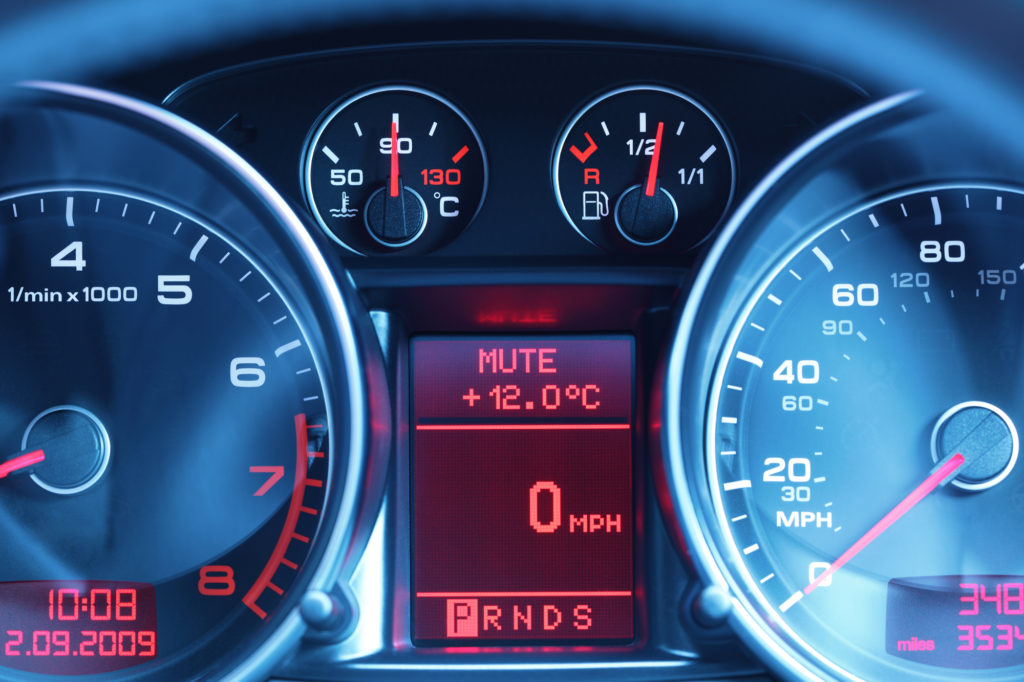Your car’s odometer reading probably isn’t something you pay much attention to since it’s not vital to the vehicle’s operation, as the amount of gas in the tank or whether the tires have the correct PSI.
Here are some things you should know about your car’s odometer reading, especially if you want to buy or sell a vehicle.

The odometer reading is the string of numbers that show on the odometer that tells you how many miles the car has traveled. This number is typically six digits with a seventh number at the end representing tenths of a mile.
Contents
Where Is the Odometer Reading Located?
Typically, the odometer is on the dashboard, in the middle of the speedometer, or below it.
Where Does the Odometer Reading Come From?
The odometer reading measures how far the car travels. The number comes from a calculation that multiplies the circumference of the tires on the vehicles by how many times they rotate.
Is Odometer Reading the Same as Mileage?
Yes. The odometer reading shows a number that is the car’s mileage, which is the total distance it has traveled in miles. Learning to understand this number will help in preserving the health of your vehicle.
How to Check Odometer Reading?
Learning to check an odometer reading is pretty straightforward. All you need to do is follow these simple steps:
- Look for a set of six numbers in a rectangle, usually in the center or center-bottom of the speedometer. The numbers can be mechanical, but they’re often digital in newer cars.
- That number is the number of miles that your vehicle has traveled. Some cars may even have “miles” or something similar written near the number to help pick it out from the other data present in your dash.
How to Check Odometer Reading Online?
You have a few options to check a car’s odometer reading online. You can go to CARFAX, use another free site, use your state’s odometer check page if they have one, or contact your state DMV for records.
CARFAX
To check the odometer reading online at CARFAX:
- Go to the CARFAX website.
- Enter the Vehicle Identification Number (VIN) of the car in question and your email address.
- CARFAX will provide you with the last reported odometer reading of the vehicle.
- Not every car will have records with CARFAX, so unless you’re buying a used car that the owner reported to the service, you might not get results.
State DMV
To check the odometer reading through your state’s DMV:
- Look for an official free site where you can check the last reported odometer reading. One example is this New York State Department of Motor Vehicles odometer check site.
- If your state doesn’t offer an online lookup, you can Google your state’s DMV site or use this US government site to find the link.
- At your state’s DMV site, fill out the form and pay the fee to request a copy of the title. Each title shows the odometer reading at the time the title was issued.
Other Websites
Search for “free odometer check online,” and you’ll find several sites where you can input a VIN for an odometer reading, like EpicVIN.
What Is a Normal Odometer Reading?
There is no normal odometer reading. Depending on their age and how often the owners drive, cars can have 250,000 miles or more on the odometer.
What Odometer Reading Is Too High?
There is no odometer reading that’s technically too high. To determine if a car is driven a lot, you can divide the number of miles shown on the odometer by the age of the car according to its model year.
For instance, if the odometer says 30,000 and the car is two years old, divide 30,000 by 2 to get 15,000. That’s the average number of miles driven in one year.
The average driver in the US puts 12,000 to 15,000 miles on a car each year, so that would be average mileage. If the number of miles per year is higher than 15,000, the driver puts high mileage on the vehicle.
Odometer Reading Terminology Explained
There are a few terms and phrases to become familiar with when you’re figuring out the things you should know about your car’s odometer reading.
What Is an Odometer Reading Statement?
Also known as an odometer disclosure statement, the odometer reading statement is a document that comes with a bill of sale when a car transfers ownership that states the accurate odometer reading at the time of the ownership transfer.
What Does Odometer Reading Reported Mean?
The odometer reading reported means that the owner reported the odometer reading to the DMV through an odometer disclosure statement.
What Does Odometer Reading Exempt Mean?
Some vehicles are exempt from needing odometer disclosure statements, so in a sale, the owner can write “exempt” on the title where they would typically record the mileage.
Vehicles with a model year before 2011 that are ten years old are exempt. Vehicles manufactured since 2011 need to be 20 years old before they’ll be exempt from odometer reporting.
Odometers become less accurate as cars age and rack up miles. Also, if a car was driven over 100,000 miles and didn’t change hands, it can be challenging to tell accurate mileage unless the owner discloses that the odometer rolled over.
The exemption is federal, so some states have slightly different regulations and exemptions.
What Is a Federal Odometer Reading?
The Federal Odometer Act requires owners to report vehicle mileage during sales and prohibits tampering. When the seller records the odometer reading, it’s a federal legally binding document.
What Does Odometer Reading No Tenths Mean?
When you fill out forms like the odometer disclosure statement for title transfers, the blank for the odometer reading often says “no tenths.” This phrase simply means that you should write down only whole numbers, not the last digit on the odometer that measures tenths of a mile.
What Is a Certified Odometer Reading?
An odometer disclosure statement is a certified odometer reading because the document is legally binding. When you write the odometer reading on the disclosure statement with the date you took the reading, it becomes the certification date of the odometer reading.

How To Write Odometer Reading on the Title?
Each state’s odometer disclosure statement form looks a little different, but they ask for the same general information.
To write the odometer reading on the title and the disclosure form, look at the six whole-number digits and copy those exactly. Don’t include the final number that measures tenths of a mile.
If your odometer is mechanical, that number will typically be a different color, like while with a black number if the rest are black with a white numeral, or vice versa. When it’s measuring a portion of one-tenth, the number will be rotated and not perfectly in line with the rest.
If your odometer is digital, the last number will come after a decimal point.
Don’t include that final number when you write the odometer reading on the title or the odometer disclosure statement.
If you know there’s a discrepancy in the odometer reading, such as an odometer that might be inaccurate, you must check the box to declare that on the disclosure statement. If you’re unsure the number is accurate because it might have rolled past 100,000, you must declare that, too.
Odometer Reading FAQs
Let’s look at some of the most frequently asked questions about the things you should know about your car’s odometer reading.
Is It Illegal To Change the Odometer Reading?
Yes. The Federal Odometer Act makes it illegal to tamper with a vehicle’s odometer reading to change the numbers or interfere with the odometer’s operation to display false mileage.
How Can You Verify an Odometer Reading?
You can use the steps listed above to check the odometer reading online through CARFAX, VIN lookup websites, and your state’s DMV services. A title search at the DMV will give you the last recorded odometer reading.
If those numbers are old, you can look for an oil change sticker on the windshield or receipts in the glove compartment. Most oil change stickers suggest the next mileage when you should have an oil change. Their documentation and receipts may also list the number.
Does Tire Size Affect Odometer Reading?
A car’s odometer measures tire rotations based on a tire’s circumference times rotations. The tire’s size doesn’t matter as long as it’s the original size built onto the car. Manufacturers calibrate the odometer to record distance accurately based on the original tire size.
If you change to a smaller or larger tire, you’ll need to have your mechanic calibrate the odometer to the new circumference measurement for it to record the mileage accurately.
What Is the Average Odometer Reading on a New Car?
Most new cars will show mileage on their odometer reading of between 10 and 50 miles. Some vehicles might display as many as 200 miles if they came from a dealership or factory to a showroom some distance away.
Even a brand new car will have more than 0 miles on the odometer because new cars will show miles from being moved during transportation.
If a new car has 200 miles, it might have been transported from a distance or have been used for many test drives before you purchased it. A new car at a dealership lot is more likely to have an odometer reading of three digits than one delivered to you from the factory.
Do You Need Odometer Reading for Insurance?
The insurance agent will ask for your car’s odometer reading when you buy auto insurance. They may also verify it by checking the odometer, requesting the information from the DMV through a title search, or asking you to use a tracking device.
Some insurance companies ask for mileage statements annually. When you get one, you self-report your vehicle’s odometer reading.
This number lets them calculate the number of miles driven since the prior year to determine how little or often you’re on the road so they can adjust their rates if necessary. The more you drive, the higher your insurance rates typically are.
OBD-II Devices
They may also ask you to plug in a small device to your vehicle’s OBD-II port. The port is underneath the steering wheeling on the underside of the dashboard in most vehicles.
The device collects odometer information and your driving statistics like speed, minutes traveled, how often and how hard you brake or accelerate, and other information and wirelessly shares it with the insurance company.
By using a device like this for up to six months, you may qualify for insurance discounts, though if you drive many miles per day, speed, brake hard, and drive aggressively, it could cause your rate to go up.














